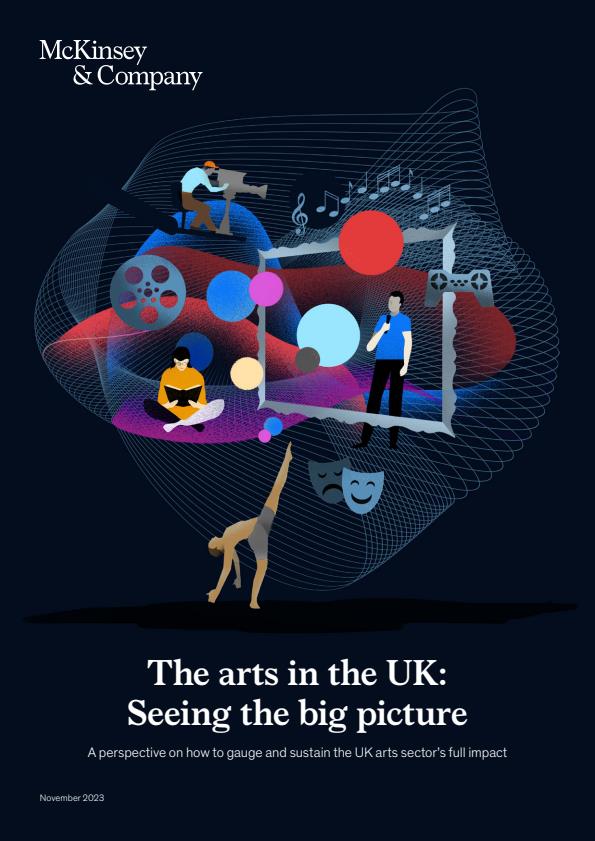Skills and educational outcomes
Engagement with arts activities can help individuals develop a broad range of core skills, including memory, problem-solving, spatial–temporal performance, and executive function.1 It can also boost the self-confidence of children. One University College London (UCL) study found that those who took part in arts activities scored from 16 to 32 percent higher on questions related to self-esteem than those who did not.2
Engagement with the arts can help improve educational outcomes, as well. The Cultural Learning Alliance (CLA), for example, found that participating in structured art activities could boost young people’s attainment in literacy and maths and increase their cognitive capabilities by 17 percent.3
In fact, the recognised impact of the arts on educational outcomes is so strong that the Welsh government, in partnership with the Arts Council of Wales, introduced the Creative Learning Through the Arts programme in schools across the country.4 The aim was not only to improve children’s experience of the arts but also to implement the curriculum more creatively by drawing in professionals such as musicians, writers, actors, and dancers.
What was the result? Teachers found that students’ attainment across the five “creative habits of mind”—inquisitiveness, persistence, collaboration, discipline, and imagination—improved, on average over a four-year period, by six on a scale of one to ten (ten means a significant improvement).5
Wellbeing and health
Perhaps most easily understood is the impact that engagement with the arts can have on individual wellbeing. UCL’s Arts, Culture & the Brain report (commissioned by Arts Council England) drew on findings from the Understanding Society survey of more than 100,000 people. The report concluded that attending arts events and venues correlates with greater happiness and a positive mood.1 Listening to music, drawing, and writing as hobbies have a similar impact, the report noted: such activities can reduce stress levels by providing distractions from negative or irrational thoughts and emotions.2
The arts have been shown to influence health conditions as well. UCL’s Social Biobehavioural Research Group conducted a major cohort study in the United Kingdom and the United States. It found that people over the age of 50 who visited cultural venues every few months had a 32 percent lower risk of developing depression over a ten-year period.3 In addition, music-based interventions—group singing or drumming or listening to music, for instance—have been found to help manage depression and to help prevent other conditions, such as dementia.4 Music activities can also improve balance, lung function, speech, and other physical functions in patients with Parkinson’s disease.5
Recognizing the link between participation in the arts and improved wellbeing and health, the National Health Service (NHS) has now made art activities part of a social-prescribing programme: health professionals help patients to manage their conditions by, for example, attending poetry clubs, painting classes, or many other (often community-based) arts events.6 The ambition is to prescribe arts and other activities for more than 900,000 people by 2023–24. That goal will require substantial support from arts organisations and practitioners.7
Many of them already work with NHS trusts and healthcare providers. For 15 years, Royal Liverpool Philharmonic has been partnering with NHS Trusts, including original partner Mersey Care NHS Foundation Trust, for example. They support patients with a range of physical- and mental health conditions by offering them person-centred music activities and helping them attend performances and events at Liverpool Philharmonic Hall. The longevity and growth of the programme, and the number of patients benefitting from it—18,000 to date—point to its success.8
In another such programme, the not-for-profit Artlift set up a scheme with nine GP surgeries in Gloucestershire: patients suffering from conditions such as depression, anxiety, chronic pain, and stroke were offered the chance to sign up for an eight-week course led by a professional artist working in poetry, ceramics, drawing, mosaics, or painting. The resulting health benefits were significant. In the year after the programme, GP consultation rates dropped among those taking part by 37 percent and hospital admissions by 27 percent relative to the previous year—equivalent to a saving of £216 per patient.9 Artlift now runs similar schemes in partnership with the NHS.











